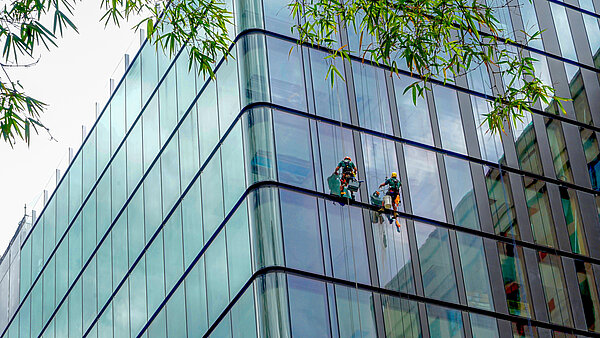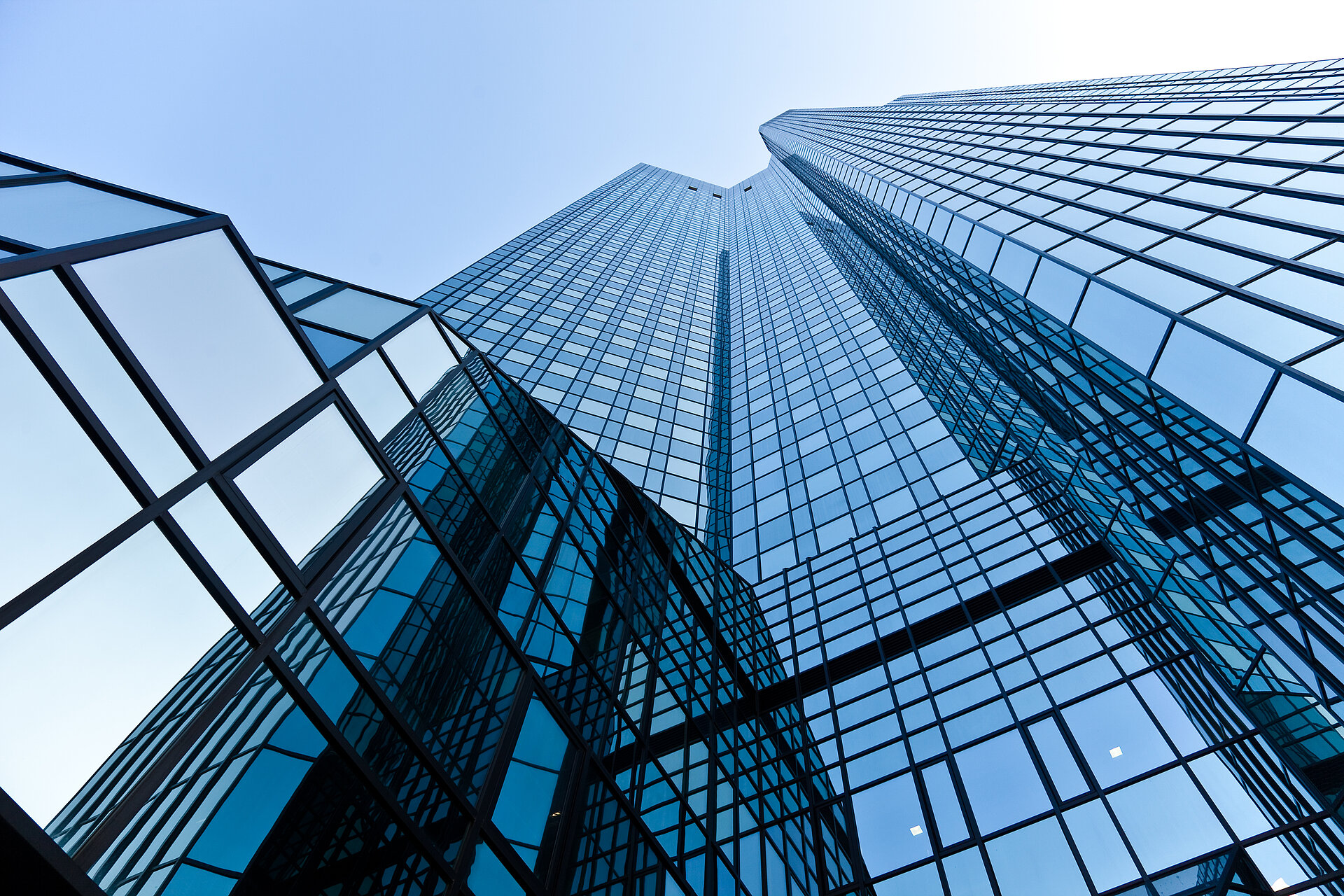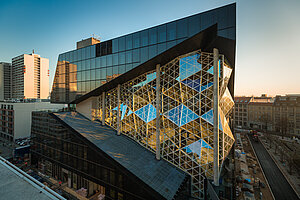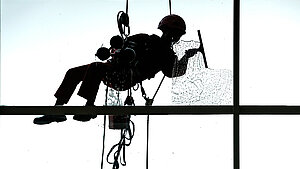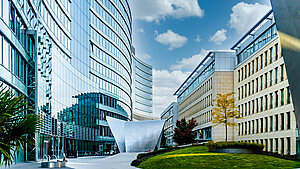What is rope access technology?
Rope access technology is a recognised process for enabling tasks to be performed at difficult-to-access positions, such as on building facades. For what we call industrial climbing or facade climbing, the international designation “rope access” is usual. Typical areas of use for workers at height include inspections, repairs, and cleaning on wind turbines, facades, towers, and silos, as well as production and storage halls. On facades, rope access technology functions very well as an alternative to raised working platforms or facade scaffolding. Here, the major benefits of rope access technology are:
- Fast and flexible operational capability of the industrial climbers
- Cost savings, because rental and installation costs for conventional access equipment no longer arise
- No impediments or restrictions to surrounding areas from scaffolding or lifting platforms
While fall protection systems are primarily intended as passive safety systems whose primary duty consists of trapping a fall, in rope access technology the rope is permanently under load, and is a component of the activities on the facade.
Rope access technology systems
The rope access technology system can be designed as either single anchor points or as a rail system (e.g. TAURUS), depending on the requirements in terms of:
- Aesthetics
- Situation-related circumstances
- Time requirement
- Facade type
Technically speaking, an economical system for servicing and repair in exposed locations can often be achieved only by means of rope access technology. This safety solution optimally unifies safety and aesthetics.
Legal foundations for rope access technology on facades
The legal basis which is decisive for the European Union derives from Directive 2009/104/EC. For workers at height and industrial climbers, the two ISO standards ISO 22846-1 (Rope Access Systems - Principles) and ISO 22846-2 (Rope Access Systems - Code of practice) are also of importance. They contain the first attempt at an international level to define all equipment, processes, and training required for rope access technologies.
Legal foundation in Austria
In Austria the relevant provisions of the directive were implemented in § 6 section 7f of the Bauarbeiterschutzverordnung (BauV [construction worker protection regulation]) in particular. This states that rope access technology may be implemented only if:
- the determination and assessment of the dangers have indicated that the work can be performed safely, and that the use of other equipment (…) is not warranted
- suitable personal protective equipment is used to protect the employees
- the working line must include a self-securing system which functions as fall protection
- careful planning and monitoring ensure that immediate assistance can be provided to employees if required
- the employees are specially trained, particularly regarding working and rescue processes
Furthermore, the general provisions of § 4 and § 5 of the ArbeitnehmerInnenschutzgesetz [act on protection of workers] must be complied with, especially in terms of determining and assessing dangers, and regarding documentation requirements. In addition, for working and safety systems, regulation 2016/425 (EU) (“regarding personal protective equipment and the repeal of directive 89/686/EEC of the Council”) is also pertinent. The Labour Inspectorate of the Federal Ministry of Labour provides a general overview of this.
Legal foundation in Germany
In Germany, Directive 2009/104/EC was implemented in the Betriebssicherheitsverordnung (BetrSichV [ordinance on industrial safety and health]). In Germany, this governs the provision of work equipment by the employer, the use of work equipment by the employees while working, and the setting up and operation of equipment requiring monitoring in terms of worker protection. It accordingly also states that rope access technology may be used “if the risk assessment finds that the affected work can be performed safely”.
The technical rules for industrial safety (TRBS) are also significant for the authorisation of rope access technology as working equipment.These reflect the state of the art, of occupational medicine and hygiene for the provision and use of work equipment and for the operation of equipment requiring monitoring, at the time of publishing the rules. They are compiled by the Ausschuss für Betriebssicherheit [Committee on Work Equipment], and fully replace the operating regulations from previous technical rules such as TRA, TRB, TRR, TRD and TRAC.
Legal foundation in Switzerland
In Switzerland, articles 28ff of Verordnung über die Sicherheit und den Gesundheitsschutz der Arbeitnehmerinnen und Arbeitnehmer bei Bauarbeiten (BauAV [Regulation relating to safety and protection of health of workers during construction work]) and articles 5, 8, and 32a of the Verordnung über die Verhütung von Unfällen und Berufskrankheiten (VUV [Regulation relating to prevention of accidents and occupational illnesses]), are to be applied in particular to rope access technology.
Read on: You will find more about the legal foundations, liability, and standards for fall protection in industry in our review article.
Benefits of rope access technology
In contrast to other access techniques, rope access technology possesses numerous benefits:
- Optimum accessibility
By means of rope access technology, it is possible to reach even parts of facades which are difficult to access using conventional means (or cannot even be serviced or repaired).
- Low-cost alternative
Above all, when rope access technology has been considered as early as the building planning stage, it represents a cost-effective variant when compared with cranes, lifting platforms, or scaffolding.
- Retention of appearance
Rope access technology can be integrated almost invisibly into the aesthetics of a facade. Numerous components are available to ensure optimum results for all facade types.
- Safe process
If the applicable standards are complied with, rope access technology represents a very safe process. Its use requires attendance at training to become a certified worker at height, and there are binding rescue concepts which define standards in the event of an accident.
- Flexible and short-term operational capability
A permanently installed safety system allows flexible deployment planning, independent of equipment such as lifting platforms or cranes.
- Maximum quality
The INNOTECH planning service provides flexible individualised solutions for your safety systems, thanks to high-class materials and maximum quality.
In many areas, rope access technology displays unbeatable advantages compared with other facade access systems. The flexible short-term deployment without additional equipment is particularly favourable. Safety and cost savings are further positive points.
For which facade types is rope access technology suitable?
Rope access technology is suitable for the overwhelming majority of all modern facade types:
- Glass facade
Unobtrusive fastening elements give the impression of a more or less smooth glass surface. The flexible access process allows the user to move horizontally, vertically, or diagonally across the facade.
- Dynamic facade/intelligent facade
With the aid of modules, for example, dynamic or intelligent facades create shade at those places on the facade where the solar radiation is especially strong, or use special photovoltaic modules to generate electricity.
- Greened facade
Concepts of urban farming or vertical farming, as well as facade greening with climatic effects: Plants release moisture to their surroundings, thus providing cooling effects and filtering the air. In addition, they measurably reduce the effects of noise, heat, and cold. Sufficient space must be planned between the rope access technology and the facade. This can be ensured through the use of STA-10 posts.
- Double facade
A heat-insulating closure to the indoor area, and furthermore a second facade to protect against environmental effects. The air located in between is heated by the solar radiation and acts as a heat buffer. Cleaning and servicing of the external facade are possible by means of rope access technology.
- Panelised facade
Prefabricated elements of steel, aluminium, or glass are combined into enormous facades. Rope access technology must be planned in from the very start, because retrospective changes to this facade type are often no longer possible.
Specifically for modern facade types, safe and economical access to facades should be discussed as early as the planning stage. Retrospective installation is often linked to high expenditure.
Planning & implementation of rope access technology
Professional planning and implementation is an essential prerequisite for successful rope access technology: On the one hand it helps to save time and money, and on the other it provides maximum safety in terms of employee protection.
Challenges in planning
- Fastening: The safety system must be accessible so that it can easily be replaced, such as when a fall stresses the rope. Environmental effects at the deployment location should also be taken into account. They can have a significant effect on the working life of the components.
- Replacement repairs: In order to provide maximum safety at all times, the securing elements require replacement at intervals. Advance planning ensures that this replacement can be performed rapidly and economically.
- Installation: Sustainable planning avoids additional expense, e.g. for expensive substructures.
- System integration: Optimised workforce routes have a minimum number of points requiring disconnection and re-connection. For the climber, these represent addition sources of error, and therefore danger.
Errors in the planning of rope access technology
- Installation of fasteners in inaccessible locations
The outcome is that repair or servicing of the system can be performed only under difficult conditions.
- Inaccessible documentation
In general there is an obligation to document safety systems which protect from falls. If this documentation is incomplete, then re-documentation must be performed. If this cannot be achieved, then the respective safety system must be replaced and re-documented! Stress can be avoided by using INNO|doc, the documentation software from Innotech.
- Misuse of systems
Safety systems must be used only for their intended purpose. Use of rope access technology for other purposes, such as material transport, is not permitted.
Invisible, yet safe: 7 tips for safety systems on facades
Collaboration with experts at an early stage has a beneficial effect on costs, plannability, and long-term safety for the users. Creation of clear and exact requirements as early as the planning phase enables an optimised implementation of rope access technology.
- Aesthetics, safety, cost effectiveness
The very top priority should always be safety. Modern rope access technology fulfils all three of these aspects: Timely planning of rope access technology and the early inclusion of experts ensure the best result.
- Plan sufficient time for the selection
Facade type and building structure are decisive for selecting the optimum rope access technology. Selection of solutions which are functional and aesthetic, as well as safe, takes time. These require consideration during planning.
- Planning in good time pays for itself
Retrospective installation of rope access technology on facades results in significantly greater effort and costs. Through well-planned systems, the cleaning and servicing of facades can be performed at any time and at short notice.
- Don’t overlook protection of access points
Those points which permit access to the facade must also be protected by suitable means. For this, something like EAP-Lock or temporary protection is available.
- Always have a fully developed safety concept
In order to avoid any form of the illusion of safety, a fully developed safety concept is essential. This consists of matching protective measures which have to be planned and implemented systematically. Involvement of experienced safety experts possessing much practical knowledge can help to avoid errors.
- Stay flexible
Rope access technology requires servicing too: Above all, damage to the rope from falls must be repaired quickly, in addition to annual inspections. Flexible systems have the advantage that it is possible to replace just individual modules, without risking the integrity of the complete system. Rail systems, which can be adapted perfectly to the circumstances of the facade, possess this flexibility. They can be adapted onsite to the building shell, and they fulfil every aesthetic, functional, and safety-relevant requirement.
- Regular servicing
Remember to maintain and check the system regularly.
Avoid the illusion of safety on facades
For rope access technology, the illusion of safety is a danger which is as real as it is avoidable. The risks lie in the potential danger of serious or even fatal injuries to employees, as well as in the financial consequences for those responsible. A sustainable safety concept contributes to minimising these risks.
How does the illusion of safety arise?
Safety experts speak of a so-called illusion of safety when safety precautions exist but they cannot achieve their full effectiveness. Perhaps because the correct precautions were not taken, or they are not sufficiently available. In addition to suitable physical safety equipment such as ropes, fastenings, barriers, etc. being available, these must also be used correctly, and an organisational rescue plan must be in place so that, if required, the necessary rescue measures can be implemented without delay.
Dangers of the illusion of safety
- Injury or death of an employee because of a fall from height
- High costs because of personnel shortage, machine stoppage, increased insurance premiums, compensation for damages, …
- Legal consequences for responsible persons (safety experts, company directors)
- Loss of image
- Financial risks which threaten a company’s existence
Avoiding safety risks
The dangers related to activities like working in or on facades can indeed never be 100 % excluded. However, the risk can be dramatically reduced through suitable safety management. And, in terms of legal liability, it makes a serious difference whether an accident is caused by negligence or not. The following safety-relevant steps are advisable for all safety systems where height plays a decisive role, regardless whether on facades, on a roof, in industry, or in other danger situations.
- Inspecting the substructure
Before installation, the substructure must be inspected, in order that the appropriate safety products and fastening materials are used.
- Planning
The rope access technology should be correctly planned, with close cooperation between the specialists (such as safety experts, structural engineers, architect).
- Installation
Careful installation by suitable fitters in compliance with the respective installation instructions and standards reduces the danger of installation errors.
- Documentation
Complete documentation (including photos) of the safety equipment is the prerequisite for the regular safety inspections, as well as providing evidence in the event of a fall.
- Anti-fall PPE
Personal protective equipment (PPE) must be suitable and adapted both for the respective user and for the area of use (type, activity, and deployment location). In addition, industrial climbers must participate in anti-fall PPE training.
- Rescue measures
Suitable rescue measures and systems must made available so that assistance can be provided rapidly and effectively in the event of a fall. Users will find background knowledge at Tutorials at MARK Save a Life, for example.
Rope access technology in everyday practice
Rope access technology is a rope-supported access process for installation, cleaning, and service tasks on facades. Certified industrial climbers can thus move within the system with relative flexibility and agility. The following sequence applies to rope access technology on facades:
- Qualification: Employees must demonstrate successfully completed training in rope access and positioning technology
- Preparation
- A risk assessment of the actual situation must be prepared in advance.
- The rescue concept also must be based on the as-found circumstances (building progress, surroundings, …).
- Personal protective equipment against falls from a height (anti-fall PPE) is to be inspected for suitability and readiness for use.
- Rescue gear must be prepared, and kept ready during the use of rope access technology.
- Weather conditions must be checked and taken into account, depending on the various facade types.
- Comply with the rules before, during, and after climbing
- Debriefing and analysis
Exact documentation can be ensured by using the digital INNO|doc documentation tool, for example.
Processes of rope access technology
A basic principle of rope access technology is “permanent redundancy” – i.e. there must be duplicate protection in each position, e.g. in the form of suspension rope and lifeline. In addition, a rescue must be possible whenever it becomes necessary. Depending on the type of task and the circumstances of the facade, different rope access technologies may be used. Three basic processes are distinguished:
- Vertical access process
A vertical access process refers to ascent and descent on a vertically hanging rope. Here the user is positioned on a seat board, and various techniques are used for ascent and descent.
- Horizontal access process
Horizontal movement based on the alternate loading and easing of load on a lanyard (such as foot loop ascenders).
- Rope change process
Complex process which is used e.g. for the rescue of injured persons.
Rope access technology - use and training
Each country has its own regulations for using and training in rope access technology:
Rope access technology in Germany
The general protection objective when using rope-supported access processes is regulated in Germany in attachment 2 of the Betriebssicherheitsverordnung (BetrSichV [Ordinance on Industrial Safety and Health]), and given concrete form by the Technische Regeln für Betriebssicherheit2121 part 3 (TRBS 2121-3 [Technical Rules for Industrial Safety 2121-3]). According to TRBS 2121-3, particular technical aptitude is a prerequisite for the use of rope access and positioning technologies. Proof of this aptitude can be provided by certificates “Worker at height, level 1”, “Worker at height, level 2” or “Supervisory worker at height, level 3”.
Courses for workers at height, levels 1 to 3 as per FISAT standards are provided by training companies who are autonomously active and financially independent of the association. The legislation requires annual instruction, and FISAT certifications are therefore always valid for a single year only. Successful participation in a refresher course extends the certification by a further year. The FISAT level (German Association for Rope Access) specifies the directions in which climbers may move on the basis of their training level:
- Level 1 workers at height are users with basic knowledge, and are trained in vertical access processes and in workplace positioning.
- Level 2 workers at height are users with basic knowledge with enhanced knowledge, and are trained in vertical and horizontal access processes and in workplace positioning. The Level 2 knowledge and skills build on the basic knowledge from Level 1.
- Level 3 supervisory workers at height are users who are responsible for the safe execution of work on a construction site at height. They are trained in advanced vertical, horizontal, and diagonal access and positioning processes. The Level 3 knowledge and skills build on the basic knowledge from Level 1 and the enhanced knowledge from Level 2.
Rope access technology in Austria
To practise rope access and positioning technology on facades, appropriate training (e.g. FISAT, IRATA) to become a certified worker at height must be given. This training simultaneously forms the basis of working using rope access technology. Once implemented on a facade, a rope access technology system may be used only by certified and competent persons. These users must meet the following requirements:
- Medical fitness verified by an occupational medical exam as per guideline G41
- First-aid class lasting at least 1 day arranged by the employer
- Minimum age of 18 years
- Training such as FISAT Levels 1 to 3, IRATA International, FSBS
- Regular training sessions: Specialist training classes provided by the manufacturer and training in PPE against falls from a height such as DGUV G 312-906 (specialist training in material testing), DGUV R 112-198 (user training in anti-fall PPE) and DGUV R 112-199 (rescue training)
According to PSA-V (regulation on personal protective equipment), annual instruction about personal protective equipment is required. § 6 Abs 8 Z 7 BauV further requires that “the affected employees are to be trained particularly in the intended work process, especially regarding the rescue process”. This special training can be obtained by participating in training certified by IRATA, for example. IRATA stands for the International Industrial Rope Access Trade Association. Up to now, this is the only worldwide association active in the area of certified working at height. The training courses certified by IRATA for becoming an industrial climber enjoy high recognition worldwide, and in many cases, it is not possible to obtain work involving rope access technology without an IRATA certificate.
Rescue systems for saving lives
According to Allgemeine Unfallversicherungsanstalt (AUVA) [Austrian accident insurance institution], every year around 15,000 accidents occur in Austria where the cause is a fall, and 17 deaths result. With appropriate planning, equipment, and training concepts, this figure could be significantly reduced. Accidents and personal injury can be avoided only if all people involved are conscious of the danger situation and are able to perform safety and rescue measures competently. However, this requires much practice and a holistic rescue concept. In terms of personal rescue in the event of a fall, Innotech offers a rescue training course, so that industrial climbers are able to help rapidly and expertly in an emergency.
In an accident, the rescue measures must be instigated immediately and professionally; delays or even the lack of a plan can have fatal consequences. Detailed rescue concepts must be drawn up in advance, the corresponding rescue gear must be ready, and the employees must be appropriately trained, so that, even under the difficult conditions of a real emergency, the rescue concept can be implemented correctly. A roughly drafted sequence for a rescue concept could look something like this:
- Recognise the situation and cease normal working activities.
- Establish contact with the person who has suffered the accident, obtain an overview of the situation.
- Make an emergency call, and make reference to a potential life-threatening suspension trauma. For remote locations (e.g. wind turbines) provide the geodata.
- Instigate rescue measures immediately, free the person from the situation in order to prevent a suspension trauma.
- Bring the person who has suffered the accident to a safe location, start first-aid measures, and instruct the rescue personnel if necessary.
- Transfer the person who has suffered the accident to the rescue service, providing all relevant information.
- Repair and servicing of the safety system
- Inspection of the fall protection system by a certified expert
- Inspection of the safety system and replacement of all stressed and deformed parts.
- Complete replacement of sliders and anti-fall PPE (harnesses, ropes, etc.)
Summary: Rope access technology on facades
Although rope access technology on facades is nothing new in principle, it has still only recently been developing its full potential as authorised working equipment. Thanks to the aesthetically pleasing systems which adapt optimally to the characteristics of buildings if planned early enough, increasing numbers of architects and developers are putting their faith into these almost invisible safety systems.
Still want to find out more about rope access technology? Then download our free White Paper as well.
















